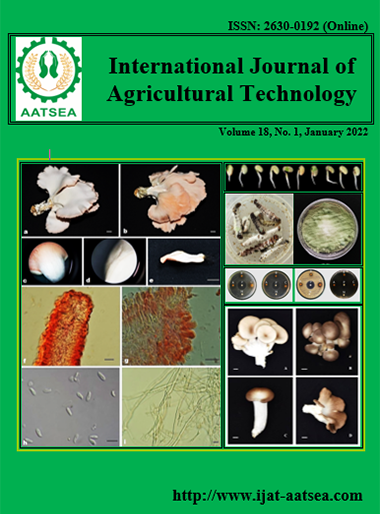Research investigation on microbial technology for plant disease control: a short communication
Main Article Content
Abstract
Chaetomium spp. are isolated, identified and screened to control plant pathogen isolated in China. Disease interacting pathogens were found in peach diseases which were Pythium, Rhizoctonia solani (twig die back), Fusarium spp (wilt) Phomopsis, Colletotrichum dematium, Colletotrichum gleosporiodes, Phoma, Fusarium, Fusarium, Phomopsis, and Alternaria. The main primary organism caused infection to peach supposing to be Phomopsis and Fusarium destroying roots and vascular bundle, and the pathogens infected above peach tree in stem, twigs and leaves found Colletotrichum dematium, Colletotrichum gleosporiodes, and Alternaria. Bi-culture test between Chaetomium antagonistic fungus and phytopathogens was evaluated to know the control mechanism which tended to give good results. Futher testing bioproduct of Chaetomium had been also tested in tea, peach, grape and old trees with different phytopathogenic isolates and reveiced a good result to control and recovery plants from disease incidence
Article Details

This work is licensed under a Creative Commons Attribution-NonCommercial-NoDerivatives 4.0 International License.
References
Aggarwal, R., Tewari, A. K., Srivastava, K. D. and Singh, D. V. (2004). Role of antibiosis in the biological control of spot blotch (Cochliobolussativus) of wheat by Chaetomium globosum. Mycopathologia, 157:369-377.
Brewer, D., Jerram, W. A. and Taylor, A. (1968). The production of cochliodinol and a related metabolite by Chaetomium species. Canadian Journal of Microbiology, 14:861-866.
Cullen, D. and Andrews, J. H. (1984). Evidence for the role of antibiosis in the 0antagonism of Chaetomium globosum to the apple scab pathogen, Venturia inaequalis. Canadian Journal of Botany, 62:1819-1823.
Dhingra, O. D., Mizubuti, E. S. G. and Santana, F. M. (2003). Chaetomium globosum for reducing primary inoculum of Diaporthe phaseolorum f. sp. meridionalis in soil- surface soybean stubble in field conditions. Biological Control, 26:302-310.
Di Pietro, A., Kung, R., Gutrella, M. and Schwinn, F. J. (1991). Parameters influencing the efficacy of Chaetomium globosum in controlling Pythium ultimum damping-off of sugar- beet. Journal of Plant Disease and Protection, 98:565-573.
Hu, Y., Zhang, W. P., Zhang, P., Ruan, W. B. and Zhu, X. D. (2013). Nematicidal Activity of Chaetoglobosin A Poduced by Chaetomium globosum NK102 against Meloidogyne incognita. Journal of Agricultural and Food Chemistry, 61:41-46.
Hung, P. M., Pongnak, W., Soytong, K. and Poeaim, S. (2015). efficacy of chaetomium species as biological control agents against Phytophthora nicotianae root rot in citrus. Mycobiology, 43:288-296.
Kaewchai, S., Soytong, K. and Hyde, K. D. (2009). Mycofungicides and funga biofertilizers. Fungal Diversity, 38:25-50.
Khan, B., Yan, W., Wei, S., Wang, Z. Y., Zhao, S. S., Cao, L. L., Rajput, N. A. and Ye, Y. (2019). Nematicidal metabolites from endophytic fungus Chaetomium globosum YSC5. DOI: 10.1093/femsle/fnz169.
Kohl, J. W., Molhoek, H. L., van der Plas, C. H. and Fokkema, H. J. (1995). Effect of Ulocladium atrum and other antagonists on sporulation of Botrytis cinerea on dead lily leaves exposed to field condition. Phytopathology, 85:393-400.
Kunze, G. and Schmidt, J. K. (1817). Chaetomium. Mykologische Hefte nebst einem allgemein-botanischen Anzeiger, Leipzig, 1-2pp.
Manandhar, J. B., Thapliyal, N., Cavanaugh, K. J. and Sinclair, J. B. (1986). Interaction between pathogenic and Technology in Agriculture saprobic fungi isolated from soybean roots and seeds. Mycopathologia, 98:69-75.
Phong, N. H., Pongnak, W. and Soytong, K. (2016). Antifungal activities of Chaetomium spp. against Fusarium wilt of tea. Plant Protection Science, 52:10-17.
Prechaprome, S. and Soytong, K. (1997). Integrated biological control of durian stem and root rot caused by Phytophthora palmivora. Proceedings of the First International Symposium on Biopesticides. Thailand, October 27-31, 1996:228-237.
Shternshis, M., Tomilova, O., Shpatova, T. and Soytong, K. (2005). Evaluation of Ketomium- mycofungicide on Siberian isolates of phytopathogenic fungi. Journal of Agricultural Technology, 1:247-253.
Sodsa-art, P. and Soytong, K. (1999). Biological control of black pepper root and basal stem rot in the field. Proc. os Symposium on Biological Control in Tropics. MARDI Training Centre, 18-19 Malaysia 1999, 68-70 pp.
Song, J. J. and Soytong, K. (2018). Research and development on bio-products in China: a short communication. International Journal of Agricultural Technology, 14:131-141.
Soytong, K. (1992). Antagonism of Chaetomium cupreum to Pyricularia oryzae. Journal of Plant Protection in the Tropics, 9:17-24.
Soytong, K. and Ratancherdchai, K. (2005). Application of mycofungicide to control late blight of potato. Journal of Agricultural Technology, 1:19-32.
Soytong, K., Kanokmedhakul, S., Kukongviriyapa, V. and Isobe, M. (2001). Application of Chaetomium species (Ketomium®) as a new broad spectrum biological fungicide for plant disease control: A review article. Fungal Diversity, 7:1-15.
Tomilova, O. G. and Shternshis, M. V. (2006). The effect of a preparation from Chaetomium fungi on the growth of phytopathogenic fungi. Applied Biochemistry and Microbiology, 42:76-80.
Tveit, M. and Moore, M. B. (1954). Isolates of Chaetomium that protect oats from Helminthosporium victoriae. Phytopathology, 44:686-689.
Udagawa, S., Muro, I. T., Kurata, H., Sekita, S., Yoshihira, K. and Natori S. (1979). Chaetomium udagawae: a new producer of sterigmatocystin. Transactions of the Mycological Society of Japan, 20:475-480.
Vannacci, G. and Harman, G. E. (1987). Biocontrol of seed-borne Alternaria raphani and A. brassicicola. Canadian Journal of Microbiology, 33:850-856.
Von Arx, J. A., Guarro, J. and Figuers, M. J. (1986). The Ascomycete Genus Chaetomium. Nova Hedwigia, 84:1-162.
Walter, D. and Gindrat, D. (1988). Biological control of damping-off of sugarbeet and cotton with Chaetomium globosum or a fluorescent Pseudomonas sp. Canadian Journal of Microbiology, 34:631-637.


